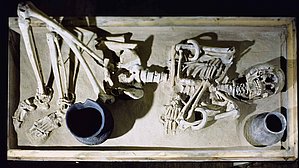Bereichsnavigation
Guidelines for the Treatment of Human Remains
Human remains in museum collections must be treated with special sensitivity. The Staatliche Museen zu Berlin is one of many museums that have human remains among their holdings. The SPK has established basic principles for dealing with human remains and formalized them in guidelines.
The cultural collections of the Staatliche Museen zu Berlin (National Museums in Berlin) are quite extensive and include human remains. The nature of these remains varies greatly, from skeletal remains (for example, archaeological finds from grave sites, or ethnological objects such as bone flutes) to human hair or skin which, in some cultures, was incorporated into artifacts. In 2011, moreover, the SPK was entrusted with the anthropological collection (called the Luschan Collection) of the Berlin Museum of Medical History at the Charité.
It was against this backdrop that the SPK developed basic principles for the treatment of the human remains contained in their collections. They are formalized in guidelines for the care and custody of human remains, for research conducted on them, and for including them in collection exhibitions. The aim of the Foundation is to gradually clarify the origins of all human remains in their collections, in order to be able to make responsible decisions regarding their further treatment. In each case, the focus will be on finding a solution that is fair and respectful.
Documents for Download
For Additional Information
Press Release
- Stiftung Preußischer Kulturbesitz legt Grundhaltung zum Umgang mit menschlichen Überresten in den Sammlungen der Staatlichen Museen zu Berlin vor (31.03.2015)
Related News
New Publication: Results of the Provenance Research on Skulls from German East Africa
18.01.2023 - Following the completion of provenance research on skulls from German East Africa, an extensive report on the pilot project has now been published. “We are prepared to restitute…
SPK begins research into the origins of human remains in a historical collection from West Africa
14.09.2021 - The provenance of human skulls from what was German West Africa is being investigated in a three-year joint research project at the Museum für Vor- und Frühgeschichte. It is funded…
Toi moko from the Ethnological Museum return to New Zealand
12.10.2020 - A ceremony was held today at the Ethnologisches Museum of the Staatliche Museen zu Berlin to prepare the mummified heads (Toi moko) of two tattooed Māori heads for their…


